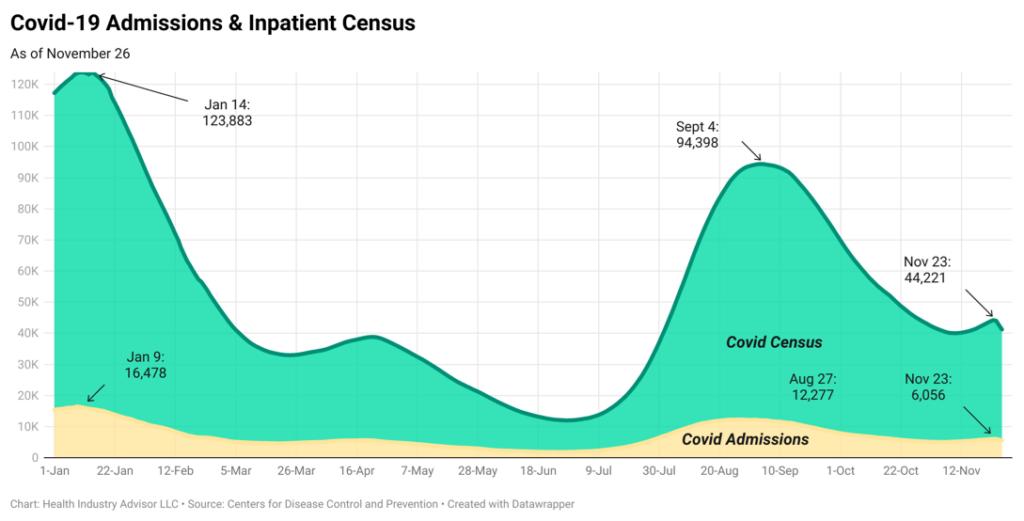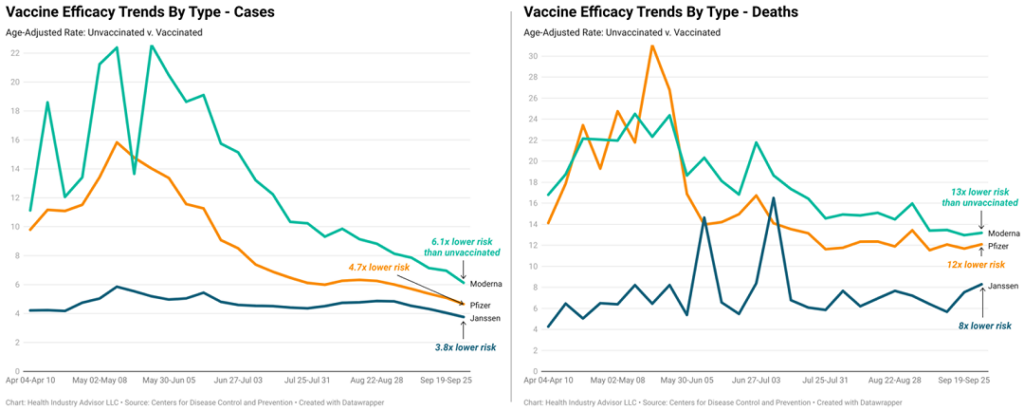November 29, 2021 – Emergence of the Omicron variant put public health officials, Wall Street, and the general population on edge late last week. Yet, we know little about this variant’s transmissibility, severity, or resistance to existing vaccines. Experts suggest that it will be a few weeks before a clear picture emerges.
As the saying goes, “nature abhors a vacuum,” and financial markets hate uncertainty. Lacking real evidence of Omicron’s impact, we witnessed a 900-point plunge Friday in the Dow Jones Industrial Average. Nervous investors foresee an uncertain week ahead.
More pertinent to this audience, uncertainty reigns over Omicron’s impact on the health care system. Lingering concerns remain about the Delta variant and the potential for a Winter surge.
Given this uncertainty, let’s explore the current state of the Covid-19 pandemic in the United States.
Reported new daily cases started increasing early in November, raising concerns about a fifth wave this Winter. However, recent data suggest that any such wave – pre-Omicron – has developed slowly, if at all.
The seven-day average new reported case rate stabilized over the five days preceding Thanksgiving, following 16 days of modest growth. Estimated new infections, accounting for unreported and undiagnosed cases, dropped each day from September 1 through last Monday. Estimated infections increased each day last week, albeit modestly.
One area of concern – the test-positive rate rose to 6.2% last week, from 4.9% in early November. Public health officials prefer a rate of 5% or lower to endure adequate surveillance.
Another concern, hospitals and caregivers came under more significant stress during the month, exacerbating staffing issues and fatigue from the now twenty-two-month-long pandemic. Covid admissions rose daily from November 5 through Thanksgiving eve. Covid census followed suit, rising each day from November 11 until the holiday. (Both counts receded during the holiday weekend). Nevertheless, admissions and census are half of the early September levels.

Omicron’s potential emergence underscores the utility of vaccinations, including getting booster shots as available.
Last week, the CDC updated its reporting on vaccine effectiveness. The latest data cover the period through October 2.
Several intriguing insights emerge from the new CDC data:
- Vaccines reduced the risk of infection by 5x and the risk of death by 13x for the week ending October 2
- However, vaccine effectiveness waned over time – In May, the vaccines reduced infection risk by 15x and death risk by 24.5x
- The Pfizer and Moderna vaccines demonstrated significantly lower effectiveness over time, while the Janssen vaccine maintained its efficacy. However, the Pfizer and Moderna vaccines remain more effective than Janssen’s.
These data do not yet reflect the impact of boosters.

Young children, ages 5-11, and senior citizens lead the current vaccination efforts. Nearly one-in-eight young children received their initial shot already – more than twice as many as a week ago. Thirty-six percent (36%) of senior citizens received a booster shot already; another 50% received the two-shot Pfizer or Moderna regime or single-shot Janssen one.
Contributing writer:
Mark A. Van Sumeren, strategic advisor, Medical Devices & Integrated Delivery Networks
Health Industry Advisor LLC, provides a regular report on COVID-19 numbers for the health care industry.
For more information, or to sign up for the report, contact Mark at Mark.VanSumeren@HealthIndustryAdvisor.com; or visit www.HealthIndustryAdvisor.com.
